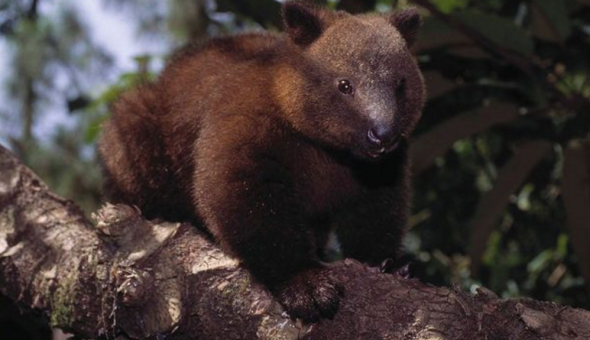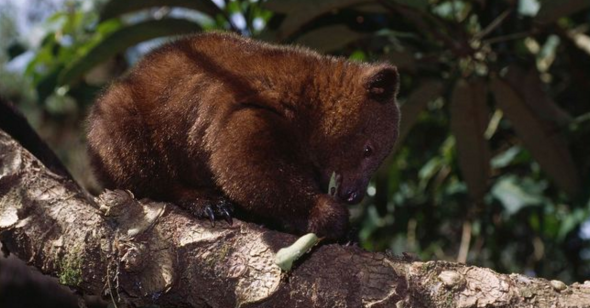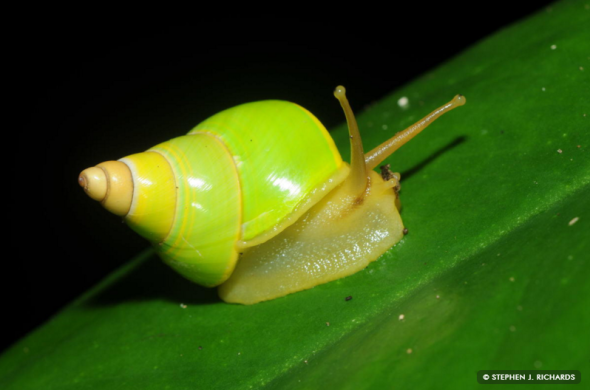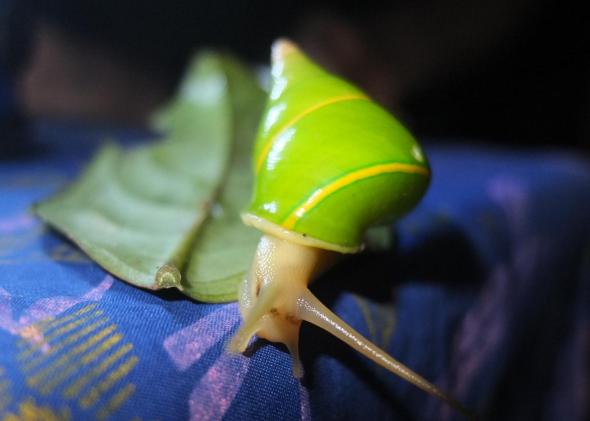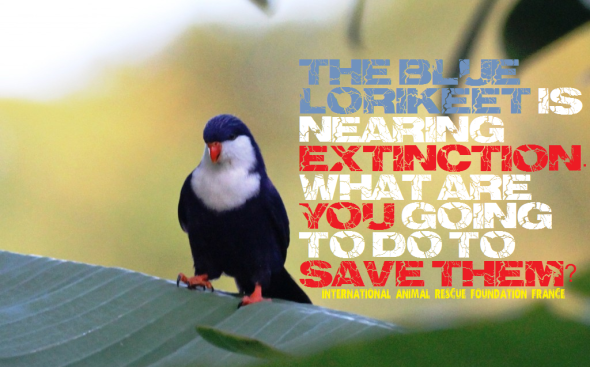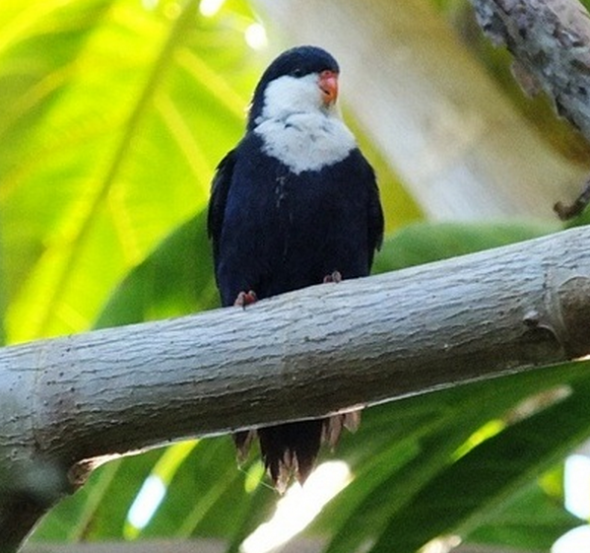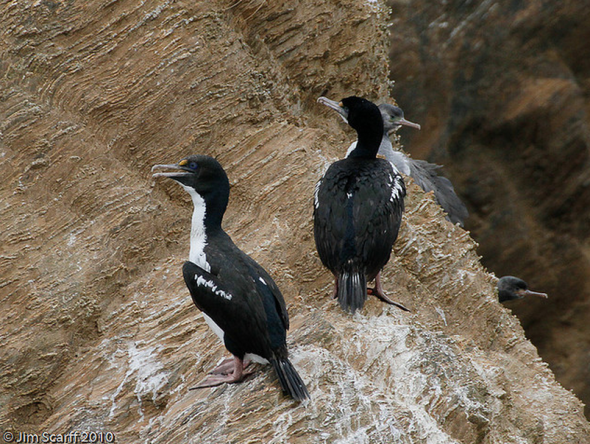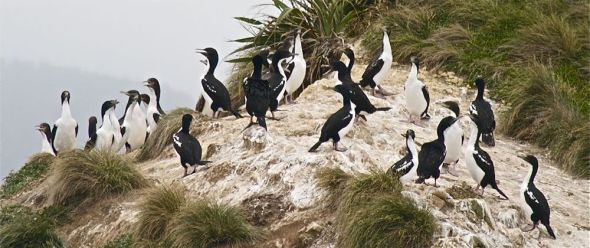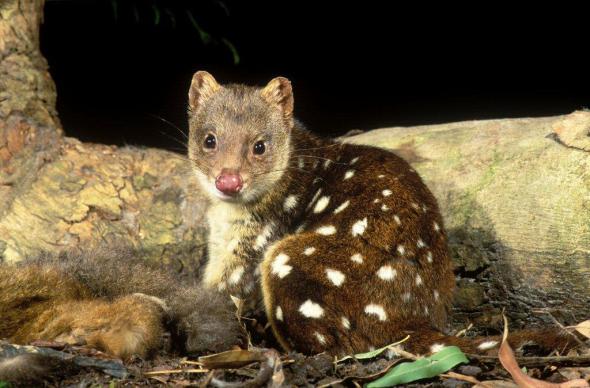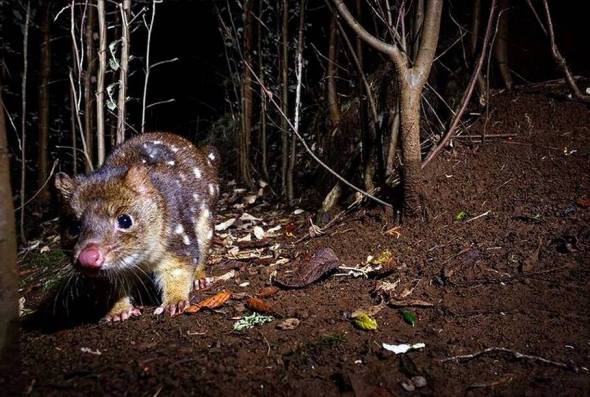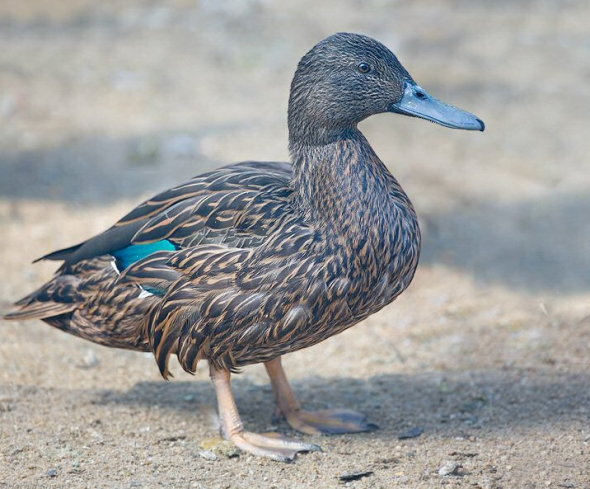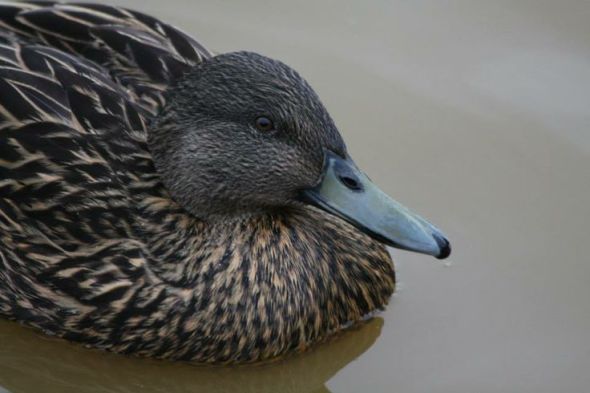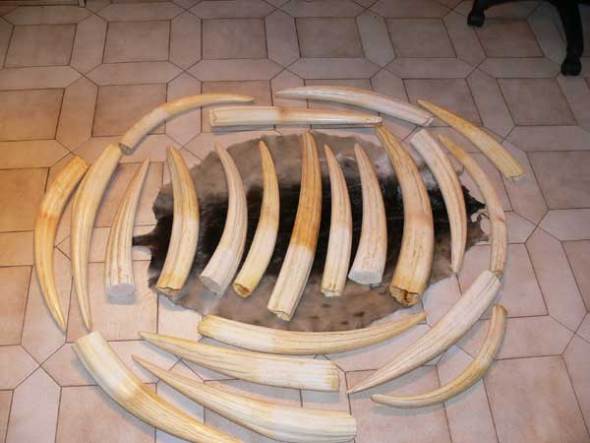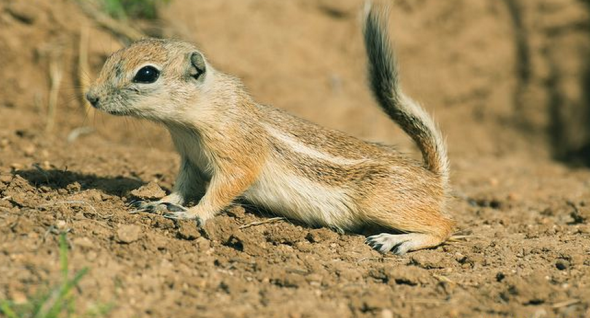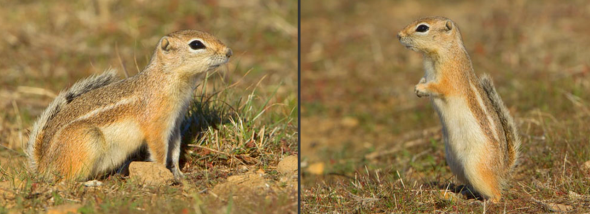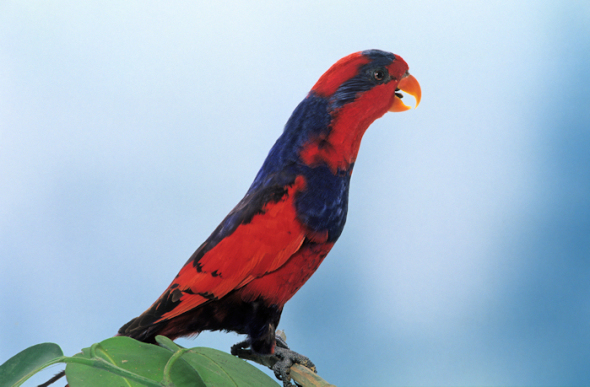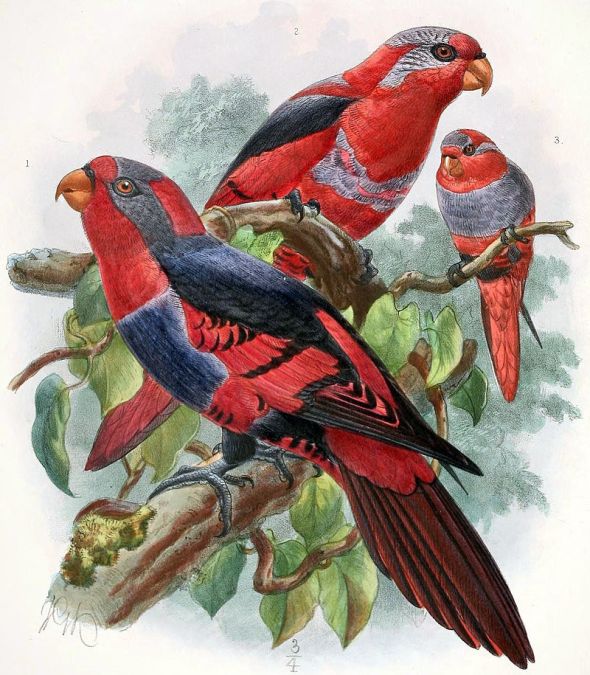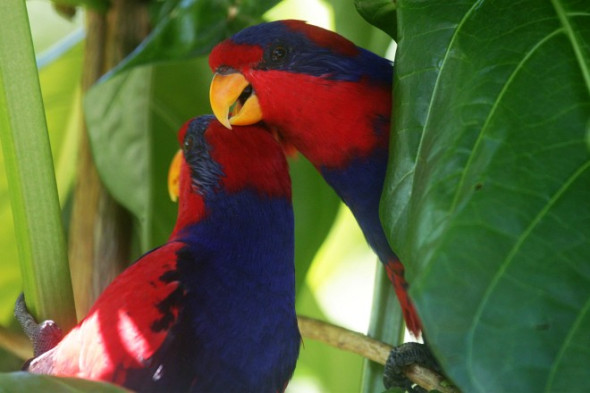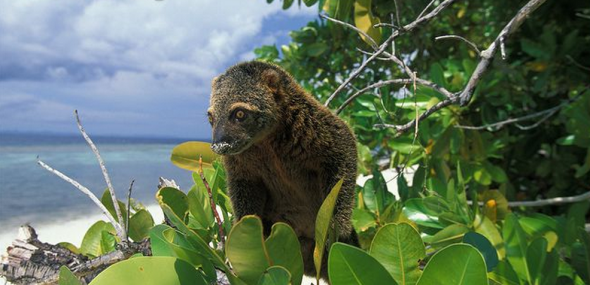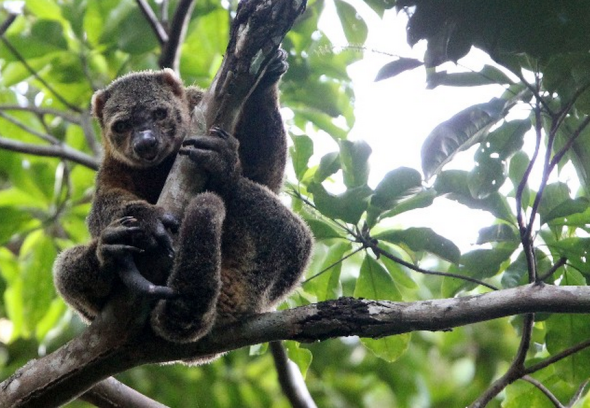Endangered Species Friday: Dendrolagus dorianus | Cuddly Teddy Bear Facing Extinction.
Endangered Species Friday: Dendrolagus dorianus
This Friday’s (Endangered Species Post) [E.S.P] I touch up on this rather unusual species of tree kangaroo that’s rarely mentioned within the world of conservationism. Furthermore I also wish to set the record straight about these wonderful and utterly adorable species of mammals which many people seem to believe are endemic ‘just to Australia’. This particular species is actually native to Papua New Guinea, generically identified as Dendrolagus dorianus. (Image credits: Daniel Heuclin).
Listed as (vulnerable), the species was primarily identified by Dr Edward Pierson Ramsay (3 December 1842 – 16 December 1916). Dr Ramsay was an Australian zoologist who specialized in ornithology. Among organisms Dr Ramsay named are the pig-nosed turtle, giant bandicoot, grey-headed robin and Papuan king parrot.
D. dorianus lives within a country of immense cultural and biological diversity. A country known for its beaches, coral reefs and scuba diving. Not forgetting the countries inland active volcanoes. Locals commonly identify the animal as the; Doria’s tree kangaroo or the unicolored tree kangaroo. Doria’s tree kangaroo is within the order of Diprotodontia, and the family identified as Macropodidae.
Since 1982 to 1994 the species has remained at [vulnerable level] of which back in 1996 a further assessment of the species noted a possible population decline. The decline prompted environmentalists to notch the species further up the list of [vulnerable species]. However a survey in 2008 concluded the species hadn’t as yet qualified for any further threatened status (E.g) endangered (which would unfortunately be the next listing should threats not decline in the wild).
Scientific research and population evaluations have shown a staggering 30% decline of overall wild populations which is quite a large population decrease, although “allegedly not concerning enough as yet to reclassify this particular specimen as endangered”. Yes its unfortunate that the current news relating to (decreasing populations), is indeed factual, and its likely (as explained), that should threats in the wild not decrease anytime soon, we could see a new extinction occurring in as little as ten years “if not sooner”. Populations are not known to be ‘fragmented’.
Image: Rare glimpse of the Doria Tree Kangaroo.
Identified in 1883 there are very few conservation actions actually known that could help increase declining population sizes which I myself find somewhat frustrating, not to mention perplexing, especially when one takes into consideration the current level of threats associated with this specie in Papua New Guinea.
Research proves the species inhabits some several protected national parks [NP’s], unfortunately extreme hunting activities I.e illegal poaching is still ongoing. While Anti Poaching Operations [APU’s] do exist, the fact of the matter is that Cites (The Convention on International Trade of Endangered Species Wild Flora and Fauna), still hasn’t listed the species as (protected or endangered) on either Appendix I or Appendix II.
Image: Extinction may occur in a decade of not sooner.
To date the current population level is unknown, furthermore reproduction is also believed to be incredibly low and poor.
MAJOR THREATS
Known threats relate to the bush meat trade, which if not controlled will unfortunately push the species into extinction. Hunting with dogs, unregulated/illegal hunting is quite high and problematic within the region. Finally the species absolutely hates canines of which when threatened emits depressed vocalizations. Future threats have been identified as habitat loss and degradation.
The Doria’s tree kangaroo lives at elevations of some 600-3,650 meters of which is mostly nocturnal and a solitary animal. Dr Ramsay named the species after Professor Marquis Giacomo Doria (1 November 1840 – 19 September 1913) whom was an Italian naturalist, botanist, herpetologist, and politician of Italy.
Doria’s tree kangaroo is probably one of the largest species of tree kangaroos on the planet, although this is somewhat debatable. Weighing in at 6.5-14.5 kilograms, length is around 60-80 centimeters, with a tail length of some 40-70 centimeters. With a large tail, dense black and brown fur, large powerful claws and stocky build, the appearance of this specific animal almost appears to look like a medium sized bear.
Diet consists of leaves, flowers, fruits and buds, there is no evidence that suggests or points to any form of meat eating either. Gestation period of females is around thirty days, of which the ‘single young baby’ will remain in mothers pouch for around ten months.
There really is limited information about this specific species which could be due to the fact the species is actually very rare, nocturnal, and lives at moderate to high elevations within dense montane forests. I am asking the public to please share this article far and wide to help us push more awareness of this species into the public domain, which we hope will encourage (Cites) to protect the species sooner rather than later.
This article is dedicated to Ms Toni Devine, a wonderful young lady that absolutely adores these wonderful species of animals, who wouldn’t adore them, they are truly remarkable, intelligent, and in way more like cuddly teddy bears.
Chief Environmental & Botanical Officer
Dr Jose C. Depre
Environmental Crimes Investigator
Follow me on Twitter here: https://twitter.com/josedepre11
Follow us on Facebook via clicking the link below:
https://www.facebook.com/InternationalAnimalRescueFoundationAfrica/
Endangered Species Monday: Papustyla pulcherrima | Special Report.
Endangered Species Monday: Papustyla pulcherrima
Manus Green Tree Snail - Very first invertebrate to be listed on the Endangered Species Act of the United States of America (2015) Endangered Species Post Special Report.
This Monday’s Endangered Species Post (ESP) I take a wee glimpse into the life of the Green Tree Snail, also commonly known by Papua New Guinea’s natives as the Manus Green Tree Snail. Image Credit: Stephen J. Richards.
Identified by Professor Rensch 1931, Rensch was born on the 21st January 1900 in Thale in Harz and died on the 4th April 1990 in Münster, (Germany), Professor Rensch was an evolutionary biologist, zoologist, ethologist, neurophysiologist and philosopher and co-founder of the synthetic theory of evolution. He was professor of Zoology and Director of the Zoological Institute at the Westphalian Wilhelms University in Münster. Together with his wife Mme Ilse Rensch he also worked in the field of Malacology and described several new species and subspecies of land snails.
The Manus Green Tree Snail is identified as Papustyla pulcherrima commonly known as the Emerald Green Snail. From 1983-1994 this particular species of snail was considered (extremely rare). Back in 1996 when scientists managed to again finally catch up with this stunning little mollusk, the species was then listed as (data deficient) of which to date there remains little information about this (rare) but beautiful snail.
P. pulcherrima is endemic to the Papa New Guinea northern island of Manus of which the species is listed as (near threatened), and has also been reported on the adjacent Los Negros Island. Environmental scientists have confirmed from villagers on the main Manus Island that the species is not located anywhere else. However there are some sketchy reports that the species “may be located on surrounding islands”, however there is no evidence to back these claims up.
Environmental scientists have confirmed for now that the species is located in only 12-13 areas of the Manus Island[s]. Further reports have confirmed that mature individuals are on the decline (which if not controlled could evidently see the species re-listed as vulnerable or endangered). The Manus Green Tree Snail is not believed to be living within fragmented zones. The species is restricted to forest and low intensity garden ‘type’ habitat. Declines have been noted within all 12-13 identified habitats on the Manus Island and adjacent Los Negros Islands. Population history is pretty much undocumented although has been shown to be slowly declining.
Image: Manus Green Tree Snail.
Back in 1930 when Professor Rensch identified the Manus Green Tree Snail, locals soon began collecting the species for trade thus seeing the mollusk now nearing endangered listing. Demand for the Manus Green Tree Snail has now drastically increased threatening the species furthermore. Locals continue to collect this rather unusual colored species shell for use within the jewelry trade. There are now “very serious concerns” that trade may eventually push the species into extinction.
Due to mass trade exploitation the Manus Green Tree Snail is the very first invertebrate to be listed on the Endangered Species Act of the United States of America. International trade has been controlled by export permit since 1975 under the Convention on International Trade in Endangered Species of Wild Fauna and Flora (CITES) appendix II. Unfortunately this is not stopping locals from harvesting the species, and trade is still continuing despite it now a criminal offence under United States and some international laws.
“Overexploitation threatens the Manus Snail”
Market sales data collected from the Lorengau market, over a six day period suggest that annual sales at the market may approach 5,000 shells. Investigations by the Wildlife Conservation Society (WCS) reveal that large quantities of shells are still being attempted to be exported out of the country. Online searches revealed the sale of the shells, often marketed as antiques, occurring in open forums and internet market places based in New Zealand, Australia, and the United States of America (USA). International Animal Rescue Foundation has ran numerous traces online of which located yet again Ebay as being a number one trading site of the “threatened species”, please view the image below and click the image link that’ll direct you to that site.
“EBAY JAPAN IS A HOTBED FOR ILLEGAL TRADE OF THE MANUS GREEN SNAIL”
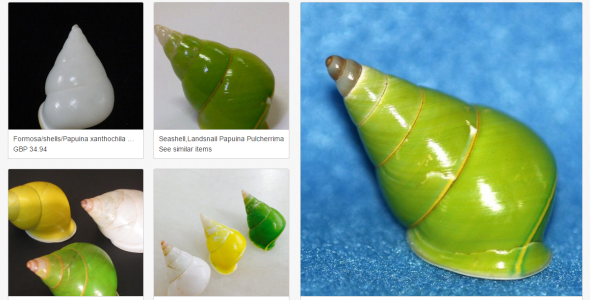
International Animal Rescue Foundation’s External Affairs Department and the Environmental Cyber Crimes Unit located many a sites trading the Manus Green Tree Snail’s shell which is illegal under some trade law, unfortunately the Ebay site listed above, located within Japan is one of many more that are trading (despite the species nearing extinction).
I.A.R.F’s Environmental Cyber Crimes Unit have since filed a complaint with Ebay, providing all the relevant data to now remove these species from their sites, however its likely to prove negative as the trader could very well state they harvested or purchased the shells before international laws were drafted. Furthermore a trace of the owner that owns this site above which is in violation of the United States and Cites laws (is located within the United States). So in regards to enforcement, breaking this link is going to be somewhat of a tough cookie. Further trade was witnessed here via what we can only believe is alleged “antiques”.
Further trade all of which is illegal has been recorded hereto - this site linked back to a Mr Rob West of 121 Henderson Road, Sheldon, Brisbane, Queensland 4157 Australia, Telephone: 610732061636. Mr West from Brisbane categorically states that he doesn’t own a shop, and is a one man band, yet clearly this link states otherwise. Further evidence revealed antique trade conducted on the Ebay site, see in the image below (illegal under United States law).
Click the image link below to view more.

“Illegal to trade under the Endangered Species Act of the United States of America”
The environmental wildlife crimes investigation team linked to TRAFFIC and Cites stated:
It is possible the avoidance of conventional nomenclature is an attempt to avoid detection by authorities. In some cases, sellers on internet market places were based in CITES signatory countries (including: Australia, Italy, New Zealand, Singapore and USA) while others were not (e.g. Taiwan). Currently, volumes of shells on sale in such online market places appear low, suggesting that the existing controls on international trade maybe adequate. However, given that the online prices of shells were often orders of magnitude greater than market prices on Manus Island, vigilance will be required to insure that illegal international demand does not fuel a resurgence in snail collection.
Despite the massive trade on Manus Green Tree Snails online and within open Asian markets, its literally impossible to determine if this trade will eventually lead to the species being pushed into extinction. However it MUST be noted that there are currently only 12-13 identified habitats that the snail currently inhabits. And based on traces online conducted by the I.A.R.F’s External Affairs Department - trade is most certainly “out of control”, and not as Cites has reported (2012).
The shell of this species is a vivid green color, which is unusual in snails. The green color is however not within the solid, calcium carbonate part of the shell but instead it is a very thin protein layer known as the periostracum. Under the periostracum the shell is yellow.
MAJOR THREATS
The Manus Green Tree Snail is mostly threatened by habitat destruction through forest clearance: logging, plantation development (especially rubber) and to a lesser extent road developments. Increasing human population growth and an increasing cultural demand for deriving cash incomes from the land will likely see the rate of forest degradation increase in the future. Harvest occurs when trees are felled as part of traditional shifting cultivation and the snails, typically found in the canopy, suddenly become exposed. Such harvesting is not uncommon but it is likely to be of lower significance than the longer term habitat degradation caused by such agricultural practices.
While harvest for illicit international trade is occurring, the volumes are not “allegedly” thought to be large compared to historic rates, although they may approach levels seen in the legal domestic trade. However, given that the prices of shells internationally are often orders of magnitude greater than market prices on Manus Island, vigilance will be required to insure that illegal international demand does not fuel a resurgence in snail collection.
Notable deposits of gold have been found in central Manus and a mine operation will likely result in the next decade although no details of the plan have been released (as of 2014). The forests of Manus Island were badly affected by the 1997-1998 El Niño which resulted in a prolonged drought. Should climatic change result in increased rates of similar conditions this may constitute a future threat to the snail species, however, current predictions suggest that future incidence of drought in Papua New Guinea will decrease (Australian Bureau of Metrology and CSIRO 2011).
Despite the reassurances from Cites, WCS and the local wildlife organisations - evidence clearly points to large scale online trade legal and illegal. Furthermore there is no telling if shells online are antique or smuggled from the Manus Islands which is very concerning.
Manus Green Tree Snail is the first such snail to be listed on the threatened list of endangered species (USA). Research also explains to us that its likely the species will be plundered into extinction - very soon. Enjoy the video.
Thank you for reading, and please be most kind to share to create awareness and education.
Dr Jose C. Depre PhD. MEnvSc. BSc(Hons) Botany, PhD(NeuroSci) D.V.M.
Environmental & Human Science
Donate by clicking the link below:
https://www.facebook.com/Anti-Pet-and-Bush-Meat-Coalition-474749102678817/app/117708921611213/
Sign up here to our A.P.B.M.C news feed below here:
https://www.facebook.com/Anti-Pet-and-Bush-Meat-Coalition-474749102678817/app/100265896690345/
Follow me on Twitter here:
https://twitter.com/josedepre11
Sources:
IUCN, WWF, CITES, WCS, Ebay, Wikipedia, Australian Bureau of Metrology and CSIRO
Endangered Species Monday: Vini peruviana.
Endangered Species Monday: Vini peruviana
This Monday’s endangered species watch post (ESP) I document on a rather elusive bird that is rarely spoken about within the conservation theater or among animal rights organisations. Listed as (vulnerable) the species was formally identified by Professor Philipp Ludwig Statius Müller (April 25, 1725 – January 5, 1776) was a German zoologist. (Image V. peruviana, photographer Tara)
Statius Müller was born in Esens, and was a professor of natural science at Erlangen. Between 1773 and 1776, he published a German translation of Professor Linnaeus’s Natursystem. The supplement in 1776 contained the first scientific classification for a number of species, including the dugong, guanaco, potto, tricolored heron, umbrella cockatoo, red-vented cockatoo, and the enigmatic hoatzin. He was also an entomologist.
Despite the birds high population size the Blue Lorikeet-scientifically named as Vini peruviana is under threat from feral cats, accidental introduction of black rats and violent storms that hit the birds native range frequently causing untold damage and catastrophic destruction to the specie habitat. Furthermore the ‘swamp harrier’ remains an all out threat to Blue Lorikeet’s range which has led to wide range species decline. Swamp Harriers predate on the Blue Parikeet mainly due to the birds color.
Endemic to the Cook Islands and French Polynesia, Blue Lorikeet population sizes are declining quite fast of which drastic conservation measures are now required to control feral cats and the accidental introduction of black rats, not forgetting measures to either reduce swamp harriers or introduce a non-endangered prey for the harrier. The last survey which I believe was undertaken sometime back in 2012 showed a ‘global population’ estimated to be at 7,200 to 9,000 individuals. Which is still quite high, however not high enough to stop the species qualifying for the classification of (endangered).
Taking into consideration range and overall total population size (at an estimate) the species falls into the ‘band’ of 2,500 to 9,000 individuals. This equates (exactly) to 1,677-6,666 ‘mature individuals’ rounded to 1,500-7,000 mature individuals. Summarizing; the exact total population size could be as low as 1,500 but no greater than 7,000 mature individuals (which is extremely concerning).
Blue Lorikeet’s have been recorded within twenty of the south-east Polynesia islands, unfortunately on seven of these islands the species has since been declared officially extinct. The species now remains sparsely distributed on some thirteen islands of which is threatened by rats, feral cats and the swamp harrier. We now know the species is situated within the Society Islands (formerly all), the northern atolls of the Tuamotu Archipelago (both French Polynesia), and Aitutaki (Cook Islands).
Image: Blue Lorikeet - Vini peruviana
Within the Society Islands conservation teams estimated that there were some 200-400 individual pairs on the Motu One and Manuae respectively in 1973 , however this may no longer be the case. On the Maupihaa island back in 1999 conservationists that believed the species to be extinct located breeding pairs. In Tuamotus 2006 surveys have shown the following data in relation to population sizes; Kaukura (1,000), Rangiroa (1,000), Arutua (500), Apataki (200) and Tikehau (50).
Meanwhile in Tiamanu Motu in Apataki atoll a minimum 300 individuals were estimated back in 1989 (this sub-population being allegedly smaller than 10 years previously). On Aitutaki, where it was probably introduced, numbers have been estimated at under 500 pairs, 2,400 individuals and 1,000 individuals (2006).
Following the devastation of Cyclone Pat (2010) a further census was undertaken to asses the impacts of freak weather patterns and catastrophic cyclones on the species. Distance sampling surveys on the island of Aitutaki (2011) showed a decrease in population size of exactly 1,400 individuals. That’s quite a substantial decline of individuals caused directly by a single yet destructive cyclone.
Blue Lorikeets depend on coconut palms for nesting and some of its food, and will frequent cultivated areas. They also roost in palm trees, rising at dawn and calling and preening before feeding. They are usually found in small flocks of less than ten birds. They are active birds, feeding on nectar, insects, and ground forage.
Image: Swamp Harrier (Wiki) - . Circus approximans
Threats
The species’s extinction from many islands is most likely due to predation by black rat Rattus rattus and to a lesser extent, feral cats Felis catus. Blue Lorikeet’s have gone extinct from Makatea in the Tuamotus could have been accelerated by a particularly violent hurricane. Its range reduction in the Society Islands correlates with the spread of the introduced Swamp Harrier Circus approximans. The accidental introduction of black rats to the islands where Blue Loirkeet persists is a continuing threat to the species. Listed on Cites Appendix II conservation actions are under way with more projects proposed.
Thank you for reading.
Dr Jose. C. Depre
Botanical and Environmental Scientist.
Endangered Species Monday: Phalacrocorax carunculatus.
Endangered Species Monday: Phalacrocorax carunculatus
This Mondays (ESP) Endangered Species watch Post is dedicated to the Rough Faced Shag, scientifically known as Phalacrocorax carunculatus. Identified back in 1789 by Professor Johann Friedrich Gmelin (8 August 1748 – 1 November 1804) was a German naturalist, botanist, entomologist, herpetologist and malacologist. (Image credited: Jim Scarff 2010)
Listed as (vulnerable) the Rough Faced Shag doesn’t appear to be listed on either appendix (I) or (II). This Monday I have chosen to document on P. carunculatus as the species is incredibly rare. Thankfully conservation efforts and improvements in relation to protection of habitat have finally stabilized the birds population count. For once in many of my articles I can finally write on a bird that’s populations are not in decline. However, as explained the species is considered one of New Zealand’s rarest specimens.
Endemic to New Zealand the species derives from the family of Phalacrocoracidae. Locals commonly refer to the species by other names such as; New Zealand King Shag or King Shag. P. carunculatus qualified for the listing of vulnerable due to its very small (stable) population size where its restricted to four islands only.
From 1992 to 2002 the estimated number of birds living on all four islands stood at a mere c645 individuals (Est). A further 100-130 breeding pairs were counted too, which is equates (roughly) to 299-1000 ‘mature individuals’. Taking all individuals and breeding pairs into consideration followed up with the last census, it concluded that some 375- 1500 individuals remain on all four islands. Had drastic conservation measures not been implemented the species could have gone extinct.
Conservation practices on all four islands have been undertaken extremely well despite the fact populations are depressed. I personally applaud the New Zealand Government and Department of Environment for their efforts, and thank them for continuing future conservation and bird management projects.
Image: Rough Faced Shag small colony.
92% of the population resides on White Rocks, Sentinel Rock, Duffers Reef and Trio Islands, in the Marlborough Sounds, with two smaller colonies off D’Urville Island. Furthermore surveys on islands have confirmed that populations have remained stable over the last fifty years.
Breeding normally occurs on small rock stacks and islets, the primary diet component is said to be left eyes flatfish. However the Rough Faced Shag will also feed on other marine aquatic specimens too.
Colonies now reside within wildlife sanctuaries that are clearly signposted on the islands reminding tourists and any wannabe poachers to stay clear of Rough Faced Shag habitat. Bird watchers are also reminded to stay clear of habitat, especially when breeding occurs due to the species being very sensitive to human disturbance. I am somewhat concerned as to how a tourist has been able to edge so close the colony within the image above. This isn’t good and as such enforcement teams must remind tour operators of the (code of conduct).
Conservation actions that are now underway include a census count every five years and, monitoring of vessels that can/do cause habitat disturbance. Furthermore development of techniques to establish new colonies of Rough Faced Shags elsewhere for future survival. A code of conduct has been established to (remind commercial boats, fishing-people and tour operators) of their obligations and duties to ensure Rough Faced Shags are not pressurized by human disturbance.
Protection of all breeding grounds has most likely been sought since last documentation on the species (2012). Prevention of marine farming next to ‘any’ colonies breeding or non-breeding and responsible fishing programs have been rolled out minimize by-catch thus ensuring the birds food source requirements are not depleted or harmed in anyway.
Threats
In the 1800s, collecting by ornithologists and hunting for the fashion trade may have affected numbers. Human disturbance (boats, aircraft and scuba divers) can cause desertion of nests and subsequent predation by gulls. New interest from tour operators in the region may increase the problem. Set-nets are sometimes placed very close to colonies and present a major risk. Birds are occasionally illegally shot. Probably the largest threat now is that of tourists or fishermen disturbing breeding and non-breeding colonies. Hence why conservation measures have been put into practice to remind and keep tourists and fisherman away from all inhabitant islands.
Thank you for reading.
Dr Jose C. Depre
Environmental and Botanical Scientist.
Endangered Species Monday: Dasyurus maculatus
Endangered Species Monday: Dasyurus maculatus
This Mondays Endangered Species Watch Post (ESP) I focus a little attention onto the Spotted-tailed Quoll. D. maculatus was identified back in 1792 by Dr Robert Kerr (1755 – 11 October 1813) Dr Kerr was a scientific writer and translator from Scotland. Dr Kerr was born in Roxburghshire as the son of a jeweler. He studied medicine at the University of Edinburgh and practiced at the Edinburgh Foundling Hospital as a surgeon. (Image adult Quoll)
Dr Kerr translated several scientific works into English, such as Antoine Lavoisier’s work of 1789, In 1792, he published The Animal Kingdom, the first two volumes of a four-tome translation of Professor Linnaeus’ Systema Naturae, which is often cited as the taxonomic authority for a great many species. (He never did start the remaining two volumes.) Please note, the Spotted-tailed Quoll is described as ‘two subspecies’ and will be noted as such during this short article.
Listed as near threatened, D. maculatus has been wrongly named by some writers as the ‘Tiger Quoll’. The species shows no resemblance to that of a Tiger nor shows any familiar behavioral traits too. There is no mention of a ‘Tiger Quoll’ within conservation literature too. So I wish to put that name to bed now.
From 1996 the species [and sub-species] was listed as vulnerable, a further 2008 evaluation of the carnivorous marsupial saw conservation NGO’s submit data to the Red List of which the Spotted-tailed Quoll now qualifies for the criteria of (near threatened). Endemic to the island of Australia the species exists as explained as two sub-species.
Sub species (1) Dasyurus maculatus maculatus was formerly distributed in south-eastern Queensland (as far north as Bundaberg and as far west as Chinchilla), eastern New South Wales, Victoria, South Australia, Tasmania (including some of the Bass Strait Islands. Maxwell et al. (1996) reported that in south-east Queensland this particular sub-species has undergone a range contraction indicated to be in excess of 30% over the last 25 years and is now rare in most areas.
Sub species (2) D. m. gracilis formerly occurred throughout the latitudinal range of the Wet Tropics World Heritage Area of north Queensland. It is now apparently extinct from the Atherton and Evelyn Tablelands, and there are few sightings south of 17o45’S. This represents a decline in extent of occurrence of approximately 20%.
Populations are decreasing of which there remains an estimated ‘20,000’ mature individuals. Populations in south-east Queensland, western Victoria (Otways and far south-west of Victoria), and coastal areas of southern New South Wales are known to be declining too. Populations in north-eastern Queensland are small, fragmented, and are <1,000 individuals. Tasmanian population numbers appear to be stable.
There is some evidence of a decline in distribution or in numbers in remaining suitable habitat (e.g., in the Otway Range), and the species is mostly uncommon (although it is present in good numbers in some areas, such as the Marengo and Chaelundi Forests).
Image: Spotted-tailed Quoll (juvenile)
Threats
The reasons for decline of D. m. maculatus are a combination of habitat loss and fragmentation, possible disease at the beginning of the 20th century, competition with foxes and feral cats, predation by foxes and dogs, and impact of widespread strychnine baiting for dingoes.
Most recently threats include non-target mortality from trapping and poisoning (there is a long-standing concern that Quolls are being killed by the use of 1080 poisoning, but this has not been confirmed and is currently the focus of a number of investigative trials).
Direct persecution is significant as they are attracted to caged birds and do not necessarily take flight when discovered. Estimated forest loss as a result of clearing within its former range in south-east Queensland is over 70%, with the majority of loss occurring over the last 20 years.
The species uses a large number of den sites throughout the year and activities that reduce the number of den logs are likely to be significant. In Tasmania this taxon is naturally rare, possibly as a result of competition with D. viverrinus, Sarcophilus harrisii, and feral cats. Road mortality could be a significant factor where high speed roads and good habitat coincide, as Quolls are attracted to feed on the carcasses of road-killed animals.
D. m. gracilis is susceptible to factors which increase juvenile and/or adult mortality, or which otherwise decrease breeding success. Such factors may include habitat clearance, logging, introduced species including cane toad, and direct killing at chicken pens, at houses, and on roads.
Conservation actions are underway with more planned soon that will work to evaluate the current species size, habitat loss, food sources and protective areas needed Etc.
Spotted-tailed Quolls are generally nocturnal and rest during the day in dens. However, juveniles and females with young in the den can be seen during the day and may leave their dens when it is light out. Quoll dens take the form of underground burrows, caves, rock crevices, tree hollows, hollow logs, or under houses or sheds. Quolls move by walking and bounding gaits. Trails are not particularly important for Quoll, although they forage and scent mark along runways and roads.
Facts
Size of the Quoll depends on the species. They can reach 14 to 29.5 inches in length and 3 to 15.4 pounds of weight.
Quoll is covered with coarse coat that can be grey, brown or black in color. Basic color of the fur is enriched with prominent white spots. Quoll has pointed snout and pink nose. Its powerful jaw is equipped with sharp teeth. Tail is long and bushy. Quoll has sharp claws on the front and hind feet that are used for holding the food, climbing and digging underground burrows.
Quolls are nocturnal animals (active during the night). Even though Quolls are agile climbers, they spend majority of their life on the ground. Quolls can consume both animals and plants. Diet is mainly based on small mammals (such as rabbits), small birds, snakes and insects. They occasionally eat fruit and nuts.
Main predators of Quolls are crocodiles and snakes. Quolls live in the underground burrows, inside the hollow trees or caves. Quoll is territorial animal.
Male’s territory overlaps with territories of several nearby females. They share communal latrines. Quoll is solitary creature which gathers with other Quolls only during the mating season.
Mating season of Quolls takes place during the winter. Pregnancy lasts only couple of weeks and ends with up to 30 miniature babies (they weigh less than one gram).
Babies spend first 8 weeks of their life inside the mother’s pouch. After that period, babies are big enough to leave the pouch and ride on the mother’s back. Young Quolls are ready for independent life at the age of 6 months. Female’ pouch is not a true pouch. It forms out of the fold of skin on the stomach after successful mating. Pouch contains only 6 teats, which means that only 6 babies out of 30 will be able to survive and complete their development. Quolls reach sexual maturity at the age of one year. Quolls have short lifespan. They can survive from 2 to 5 years in the wild, depending on the species.
Contrary to popular belief Quolls or as some people refer to this documented species as the ‘Tiger Quoll’ are not rare. The species and entire genera are in fact nocturnal, so while your asleep they’ll most likely be happily wondering through your garden or local parks and nature reserves. However the species is threatened and decreasing with a population size of some 20,000.
Thank you for reading.
Dr Jose Depre.
Don’t forget to check out the upcoming Embassy Day hosted by SAYNOTODOGMEAT.NET please click the link here below further information > http://saynotodogmeatevents.info/2015/07/26/embassy-day-september-17th-2015/
Endangered Species Friday: Anas melleri.
Endangered Species Friday: Anas melleri
This Fridays Endangered Species watch Post (ESP) focuses on a very undocumented bird known scientifically as Anas melleri and commonly known as the Meller’s Duck.
The Meller’s Duck was identified back in 1865 by lawyer and Doctor Philip Lutley Sclater FRS FRGS FZS FLS (4 November 1829 – 27 June 1913) was an English lawyer and zoologist. In zoology, he was an expert ornithologist, and identified the main zoogeographic regions of the world. He was Secretary of the Zoological Society of London for 42 years, from 1860–1902.
Listed as endangered, populations are on the decline quite extensively throughout the birds entire range. A. melleri qualified for (endangered status) back in 2012. Endemic to Madagascar the species can be located on the eastern and northern high plateau. Populations are isolated on massifs on the western edges of the plateau. Documented reports from the west of the island most probably refer to vagrant or most likely wandering birds.
Its been alleged that at some time from 2012 re-introduced populations on the island of Mauritius are now extinct - however there remains no hard hitting evidence to back this claim up, conservationists have stated that a ‘probable extinction’ occurred on the island.
The Meller’s Duck was once described as common on the Africans island of Madagascar, unfortunately there is no evidence to back this claim up either. Conservationists that visit the island regularly from International Animal Rescue Foundation Africa and have documented on the Meller’s Duck previously have been informed by locals that the species is rarely seen, however huntsmen will peddle the meat of ducks into local villages.
International Animal Rescue Foundation Africa stated the species had been documented by explorers as ‘densely populated’ on the island from the 1500’s to 1800’s. Sadly since human colonization increased on the island after the French protectorate from the mid 1800’s human population growth on the island has attributed to current decline of the species. Over the last twenty years human population has skyrocketed significantly which unfortunately has led to vast swathes of habitat destroyed and illegal poaching to occur.
“All birds seem to be within a single subpopulation which is probably continuing to decline rapidly. Extinctions are likely to occur in under a few years, five years max”…
Conservation teams like the local communities have confirmed that the species is sadly no longer common ‘anywhere’ other than forested areas of the northwest and in the wetlands around Lake Alaotra where there are some breeding pairs, but where many non-breeders collect, with up to 500 birds present. All birds seem to be within a single subpopulation which is probably continuing to decline rapidly. Extinctions are likely to occur in under a few years, five years max!.
Population sizes are incredibly depressed. We now know the species numbers at 2,000 to 5,000 individuals which equates to exactly 1,300 to 3,300 mature individuals. Should pet collection, poaching, habitat destruction Etc continue at the rate it is extinctions will as explained occur in roughly (730 days). That’s how serious the problem is.
Conservation projects are underway of which the IARF have contributed funding towards the Durrell Wildlife Conservation Trust. The species occurs in at least seven protected areas, and is known from 14 Important Bird Areas (78% of eastern Malagasy wetland IBAs) (ZICOMA 1999). No regular breeding sites are known. In 2007, there was a drive to increase the number of institutions that keep the species in captivity, and as such the bird is a nationally protected species.
Conservation actions planned: Protect remaining areas of least-modified wetlands at Lake Alaotra. Conduct wide-scale status surveys of eastern wetlands. Study its ecology to identify all causes of its decline and promote development of captive breeding programmes.
(Please note all new monetary and equipment grants provided by IARFA from August of last year to present has yet to be updated into the main transparency register onsite)
Meller’s duck breeds apparently during most of the year except May–June on Madagascar, dependent on local conditions; the Mauritian population has been recorded to breed in October and November (however as explained is likely to now be extinct). Unlike most of their closer relatives—with the exception of the African black duck—they are fiercely territorial during the breeding season; furthermore, pairs remain mated until the young are.
Threats
A. melleri is still classed as the largest species of wildfowl found in Madagascar and is widely hunted and trapped for subsistence (and for sport). Interviews with hunters at Lake Alaotra suggest c.450 individuals are taken each year, constituting 18% of the global population.
Long term deforestation of the central plateau, conversion of marshes to rice-paddies and degradation of water quality in rivers and streams, as a result of deforestation and soil erosion, have probably contributed to its decline too. Widespread exotic carnivorous fishes, notably Micropterus salmoides (although this may now be extinct) and Channa spp., may threaten young and cause desertion of otherwise suitable habitat.
Its decline on Mauritius has been attributed to hunting, pollution and introduced rats and mongooses as well as possible displacement by introduced Common Mallard Anas platyrhynchos. Pairs are very territorial and susceptible to human disturbance.
Extinction is likely to occur of which continued protective captivity projects must increase for the birds future survival and re-introduction elsewhere.
The video below depicts a Meller’s Duck captivity project in Germany.
Thank you for reading.
Dr Jose C. Depre
http://www.speakupforthevoiceless.org
Please donate to SAYNOTODOGMEAT.NET < Click the link - [email protected]
Facebook: Hotbed for Lucrative Ivory and Animal Sales.
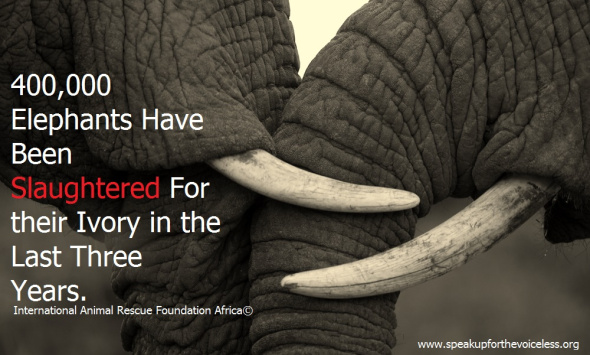
Since 2012 the External Affairs Investigations Unit (EAU), and International Animal Rescue Foundation (IARF), have unearthed a shocking trend of wildlife parts and tropical pet traders on the United States server platform of Facebook.
Operation Trojan Horse has been heading the ground-and-online hunt for traders then shutting them down via intelligence reports passed to the Police, Border Agencies and Internet Service Providers. The Intelligence gathering team state that Facebook is the new wildlife trading site whose technology conceals anything from pornography, murder, child abuse and in this case wildlife parts trade and the tropical pet trade.
Over the past several years we’ve seen a slow decline of wildlife-parts-traders and pet dealers as enforcement tightens around traders and smugglers bringing them to justice. Unfortunately, since as early as 2010 online trade has skyrocketed to new and worrying proportions. Traders intentionally use a textbook of keywords that fool Facebook’s bots and online surveillance teams, according to the External Affairs Unit [comprised of experts from ex-law enforcement officers, intelligence officers and computer experts.]
Investigative officer Tayah, who fronts the main online intelligence gathering team stated: “Firstly I begin by downloading a Virtual Private Network using pseudo details so that my location on G mail or Facebook cannot be traced. Then I have two options after signing up, creating a Facebook group or page. If say I wanted to create a group, I’d title the group using certain keywords to avoid Facebook’s bots and intelligence monitoring teams locating my network. From there I simply add trusted contacts and trade is on in under ten minutes. If I wanted to create a page, I’d again use set keywords and ensure that every country as possible remains banned from viewing the page. I then add say 50+ admins. Job done”.
Tayah makes it sound so easy but exposes a flaw: “Pages that use ‘country banning restrictions’ can still be located in the Facebook search bar. One just changes their Virtual Private Network (GPS) and you can locate anything from illegal porn, animal abuse, wildlife trading, pedophile rings down to dog fighting pages too”. Tayah went onto state: “Unless the user or anyone of the admins unpublished the Facebook page, intelligence gathering is then restricted to Facebook only. If Facebook administrators are unaware of these keywords or technology or are just lacking people power within the law-enforcement department then these ruthless traders will get away with anything”.
Working in conjunction with their Asian counterparts, IARF noticed most traders were deliberately concealing their video and image GPS as well. The problems don’t just end their either. Out of the 1.32 billion Facebook users, a staggering 32 per cent of users log in using a mobile device. One can turn the GPS off on a mobile device and download a Virtual Private Network. For all you know the friend your speaking to on Facebook that’s GPS states there from California in the United States, is really your best friend, wife, husband living with you or near you. That’s how lax Facebook’s online security is.
Tayah goes on to say “The fact I can access pages on Facebook using VPN software clearly shows Facebook is not as secure as it presents itself to be. While Facebook may have protected its millions of citizens, its allowed ruthless and very dangerous criminals to use the platform as a safe haven to buy, sell and trade in illegal animal parts, as well as children, which I’ve witnessed countless times from Russia to Karachi.”
A recent undercover survey uncovered traders selling Slow Loris within Thailand. Slow Loris are protected under Thai law and Cites law (see image below). Please click on all images to be taken to the real time evidence online. We’ve since filed the relevant reports for all and no longer require these images within our file. 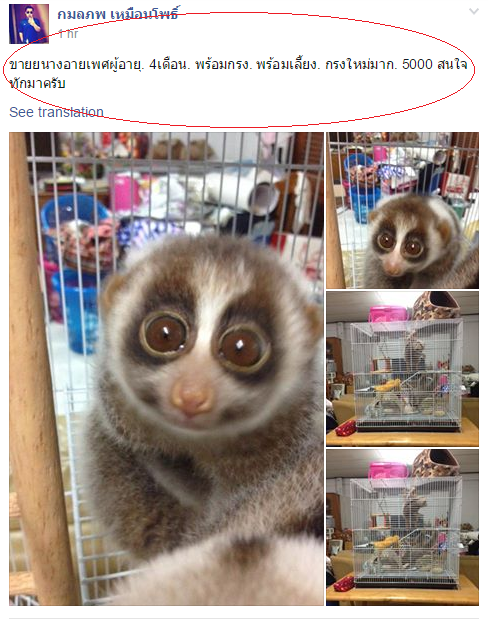
Image: ‘protected’ Slow Loris for sale on Facebook within a tropical pet group.
The trader (pictured above), is not bothered that the Slow Loris is protected under Thailand law. One species out of the five is listed as critically endangered while the remaining four remain listed as vulnerable. The tropical pet trade has been blamed on all five of the species gradually dwindling. Furthermore, Slow Loris despise being handled, brushed or kept as pets.
Slow Loris show a kind of not-bothered-look when being handled by humans. Unfortunately they cannot scream, like we do when tickled, brushed or bathed. Slow Loris hate being handled and do not make good pets. They are solitary creatures and also hate bright light. Yet Facebook has countless numbers of protected Slow Loris for sale, which is absurd, immoral and a slap in the face to conservationists and law enforcement. Is Facebook now above the law?
Facebook must be held accountable for this trade by implementing a ‘strict no wildlife or animal parts trade’ from species that are threatened within their terms and conditions. Should the United States platform not take the relevant actions then we may as well hang up our boots and go home. Frankly we’ve had enough of being ignored and fobbed off.
Endangered Tortoises can be located in many ‘Thai tropical pet and ivory’ trading Facebook forums. The image below depicts a Yellow Foot Tortoise, a species of reptile that isn’t endemic from the region of Thailand. Identified back in 1766 by Professor Carl von Linnaeus, the species is known as Chelonoidis denticulata classified as Vulnerable.
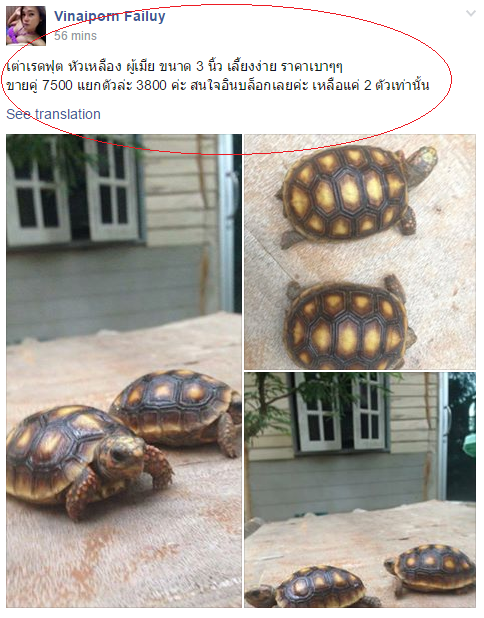
Image: Yellow Foot Tortoise are listed as vulnerable; Pet trade threatens their future.
Although not considered illegal to breed the species, EAU officers from Malaysia were mortified to know the breeder is importing the vulnerable species from South America. The unnamed breeder [not shown above], whom we cannot name, would not divulge how the tortoises are brought into the country but made it clear he could easily obtain more infants on demand, over the border from the wild.
Chelonoidis denticulata is an endangered species. The major populations located in South America are protected under the Convention on International Trade in Endangered Species, Appendix II. As with many species of Turtles and Tortoises, many Brazilian giant Tortoises end up as food items in local markets. This species of Tortoise is popular in the pet trade.
Despite the numerous specimens of endangered and nearing extinct tropical pets for sale on Facebook, one major concern is the illicit ivory trade. Back in 2013 IARF-Asia conducted a random survey within Thailand, aimed at active Facebook members of the public, both female and male from the ages of 16-21. 85% of respondents stated that they would not purchase, deal or trade in ivory and knew where ivory came from. The remaining 15% stated that they had traded, were trading or knew of relatives trading ivory and Rhinoceros horn.
We were skeptical to begin with because according to many third party reports, most whole tusks, or jewelry ivory sales appeared to be traded by adults rather than minors and teenagers. Researching Facebook from 2013 we not only discovered that Facebook was a hotbed for ivory sales - but the teenagers and minors whom IARF-Asia had questioned within Thailand were actively trading ivory online using Facebook. One trader, circled in red within the image below, brags he is trading ‘carved ivory’ within his shop, which later turned out to be his uncles shop (2013.)
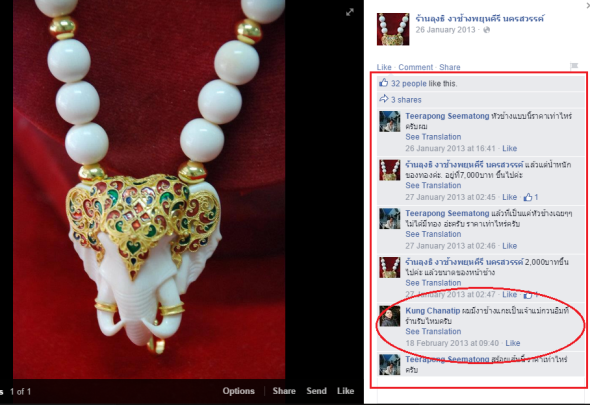
Image: Ivory traders on Facebook 2013
Since re-examining the vast majority of respondents that originally stated they were not dealing with ivory, Facebook seems to have become a hotbed for ivory sales for figurines, pendents, amulets, down to large freshly carved tusks. IARF-Asia also noticed that since Thailand’s new leader, Prayuth Chan-ocha took over the country, ivory trade has increased to shocking levels.
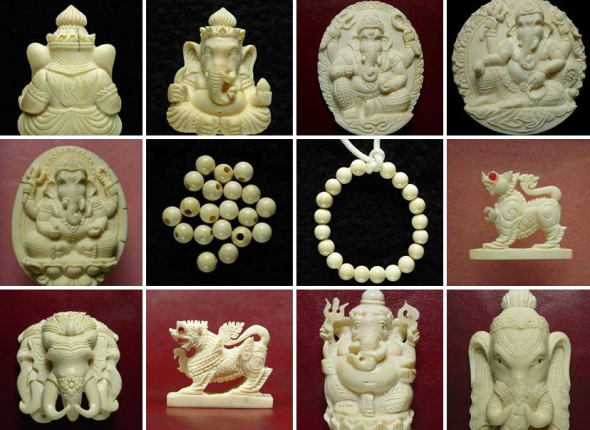
Image: Ivory Facebook profile set up as an online trade shop
Most traders will open up a Facebook account using words such as ‘ivory, ivory carvings, ivory trade, authentic ivory,’ etc. They will post photographs of some of their best selling items and then leave the page, group or their profile open for the public to view. Although the account may appear inactive, the trader silently monitors his account very closely because these profiles are created as mini shops for customers to purchase ivory pendents, charms, bracelets or carved tusks.
We are not only pointing our finger at Thailand or Facebook alone, despite Facebook seemingly unaware these traders are selling freshly carved and re-worked ivory illegally. Click on the image below and you’ll be taken through a Facebook group that is selling anything from Tiger bone wine, Bear claws and of course - ivory, in Viet Nam - on the United States social media platform.

Image: Viet Nam wildlife trading group on Facebook.
Not only insulting Africa’s heritage, but as a smack in the face to conservationists and a punch in the eye to law enforcement, one trader poses with an ivory carved Rhinoceros statue (pictured below.) Facebook is considered to be one of the largest hubs for illegal animal-parts trades that the EAU has located in years. Between 2012 -2105, IARF’s enforcement teams located multiple thousands of illegal traders openly and illegally flaunting Rhino horn and ivory.

Image: Rhinoceros figurine carved from poached ivory for sale on Facebook.
Shocked and in disbelief at the new findings by IARF’s intelligence teams, we wonder where have we gone wrong. Back in 2013-2014 a massive online enforcement campaign took place bringing down sites trading in animal parts, while Internet Service Providers (ISP) and online buy and sell sites took the pledge to not allow such items on sale. Unfortunately this has pushed many into the secretive and ‘secure’ platform of Facebook.
While there is continued demand and sale for illegal wildlife and animal parts, somewhere on the African or Asian continent an Elephant will be in the cross hairs of a poacher. The illegally poached animal’s body parts will be trafficked from Africa to Asia, then from user to Facebook, to meet the ever increasing demand that is sadly taking the social media platform by storm.
Within the past three years the Convention on International Trade of Endangered Species (CITES), stated some 400,000 Elephants had been slaughtered on the African continent alone.
There have been numerous large seizures of ivory and convictions of persons involved. Some countries are burning stockpiles of ivory to send a clear message to poachers and traders but despite these actions, the ivory trade continues. China announced in June of last year that enforcement teams had seized a total of 270 kilograms of ivory and Rhinoceros horn. Yet despite such seizures the trade goes on in the face of the law and as Facebook seems non-to-bothered some of the 1.32 billion users are using the platform as a trade and sell site laughing in the face of enforcement and conservationists.
In another shocking Facebook find, a routine search of Japanese traders revealed peddlers openly selling African Elephant ivory online. The shop (listed below), is set up as a hobby shop which works old and new ivory, creating pendents and necklaces, etc. The Japanese shop’s ivory belongs to Elephants which were illegally slaughtered on the continent of Africa, along with some re-carved antique specimens, which therefore continues demand and the illegal poaching. Please click on the image below, which will direct you to the Japanese Facebook page.
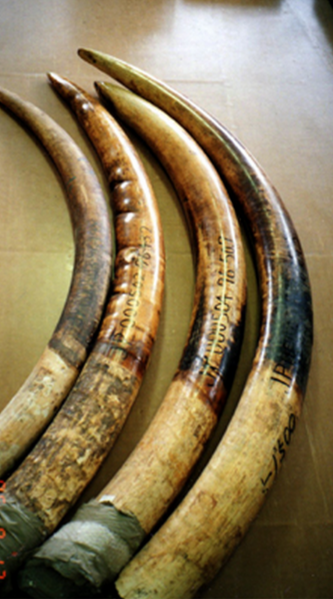 Image: African Elephant Ivory.
Image: African Elephant Ivory.
In April this year, Excellency Shinzo Abi was encouraged by major animal welfare organizations to cease trade in ivory and destroy any stockpiles being held in Japan. Since 1970, Japan has imported ivory from more than 250,000 African elephants, mainly from tusks that were illegally acquired through poaching wild elephants.
Japan has been granted permission twice to buy ivory, despite the UN Convention on International Trade in Endangered Species of Wild Fauna and Flora (CITES) 1989 ban on international commercial trade in African elephant ivory, which was adopted in response to the global elephant poaching crisis of the 1970s-80s.
In 1997, Japan secured CITES-approved ivory sales for nearly 50 tonnes of ivory from Zimbabwe, Botswana, and Namibia. In 2008, Japan was allowed to import a further 48 tonnes of ivory. Japan agreed to implement a domestic ivory control system that would prevent the laundering of illicit ivory, as a condition of both sales. This system has not worked, instead it has increased international demand for ivory and driven up poaching rates.
Of particular concern is the ivory “registration” program which can be used to grant legal status to illegal tusks or tusks of dubious legality. In the last four years alone, the Government of Japan has “registered” 5,600 tusks weighing more than 50 tonnes, bringing the total registered since 1995 to over 14,000 tusks, comprising 185 tonnes of ivory.
The “registration” of ivory tusks is a massive loophole that can be used to launder illegal ivory onto the Japanese market.
Read more here
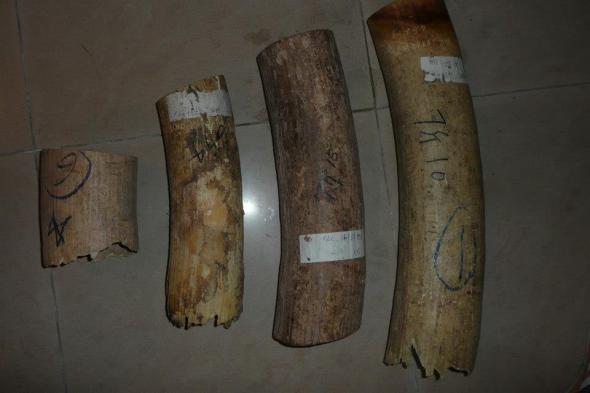
Image: Japanese Ivory trader selling freely on Facebook.
The image below was posted among other groups from a man known as Mr Houng (power), who appears to communicate with a woman known as Miss Grace Chung, who we believe is from Osarka, Japan and runs various ivory carving shops (please click the image below to view groups). While the EAU team cannot provide any real data on these two individuals, they appear to be financially well off and have no problems at locating ivory. Miss Chung has three to four Facebook groups and various pages linked to Chinese ivory trading shops. Miss Chung is directly related to the Japanese ivory dealer and ‘alleged’ hobbyist above.
Mr Houng is seen communicating to Miss Chung within her alleged ‘ivory stone and wood workshop.’ The woman states “that’s a lot,” while other Facebook users display their ivory through images, throughout this group and a further group (which we have accessed but cannot disclose at this time.) All the ivory within the image below derives from 99% non-permitted ivory, meaning its illegal and has no permits whatsoever as investigated by the EIA.
The left hand image’s GPS is from China. We’ve checked various sources in relation to the right hand image and sadly there is not a trace that we can find. Based on Mr Houng’s monetary status, it is quite possible he knows exactly whom this ivory belongs too as he posted the photograph, which seems untraceable on all five of the top search engines. It would be wrong to accuse Miss Chung of any wrongdoing in relation to either image, however the image above derives from a Japanese Facebook ivory workshop which posts images of significantly high volumes of cut off ivory pieces.

Image: close to two tons of African Elephant ivory.
Some Facebook groups and pages also contain walrus ivory which isn’t illegal if the animal died naturally or you legally hunted the animal. The problem surrounding walrus ivory is that some traders of elephant ivory use walrus ivory as a smokescreen to sell elephant ivory online. Unless you are an ivory expert, it is difficult to distinguish the difference between elephant ivory and walrus ivory. Elephant ivory traders do their best to conceal their trade by either stating their part of a walrus ivory group and/or trade Elephant ivory into, or against walrus ivory, furthermore some online ivory dealers trade under the name of ‘ox-bone’. Only ivory experts can tell the difference. Can you tell the difference from the images above to the images below without Googling?
Image: walrus tusks
Even some of the best experts can at times fall prey to the walrus ivory trade - however there is a difference. Walrus tusk ivory comes from two modified upper canines and is known as a material, as morse. The tusks of a Pacific walrus may attain a length of one meter. Walrus teeth are also commercially carved and traded. The average walrus tooth has a rounded, irregular peg shape and is approximately 5 cm in length. Lets see whom can tell the difference or if there is a difference.
Poaching of protected or managed species, trafficking and the illegal trade in wildlife and their related parts and products has escalated into an international crisis in the last decade! Wildlife trafficking is both a critical conservation concern and a threat to global security, with significant effects on the national interest of the United States and the interests of our partners around the world. For every piece of ivory that is purchased the money from that ivory then makes its way back to terrorists.
Using money from illegal trade in wildlife and related parts and products, terrorists such as Al Shabab then commit atrocities such as filmed within the video below. These atrocities are funded exclusively by each person who purchases ivory. The more ivory bought and sold, the more it empowers terrorist activity.
The video included below provides a non-graphic but powerful account of how ivory sales and trade funds terrorism. Please do view the video and take into account all those innocent civilians that could be with us today. Sadly they’re not all due to ivory funded terrorism.
The current number of remaining African Elephants is not known, due to their large migratory behavior. We do know that in Central Africa all Elephant ‘populations’ are endangered. In Eastern Africa Elephant populations are listed as vulnerable. South African Elephant populations are listed as least-concern and finally, in Western Africa Elephant populations are listed as vulnerable. Please refer to the table contents below, lifted from the last revised summery.
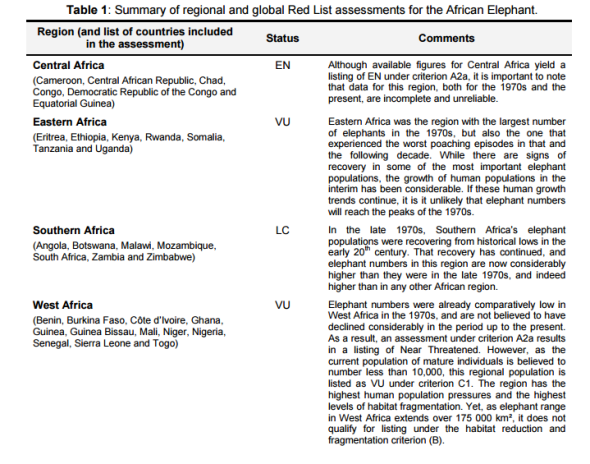 Image: table of assessments for the African Elephant
Image: table of assessments for the African Elephant
Whilst overlooking Viet Nam, CITES issued Thailand a direct warning in May, to quit the illegal ivory trade or CITES would impose immediate trade sanctions against the country. Why not Viet Nam, Japan or China?
Thailand ‘had’ until the end of March 2015 to take measures to shut down domestic trade in illegal elephant ivory or it will face trade sanctions under the Convention on the International Trade of Endangered Species (CITES), which met in Geneva last July. It must enact legislation to stem the trade of illegal African ivory in the country and implement a registration system for domestic ivory and ivory traders.
“WWF welcomes this decision and applauds the key role of the US delegation in holding Thailand accountable for their lack of progress since 2013 when it pledged to shut down its ivory market,” said Leigh Henry, WWF’s Senior Policy Advisor at the meeting. “Elephants across Africa and Asia are being slaughtered for ivory and illegal markets in countries like Thailand are allowing wildlife crime to flourish.”
Possible sanctions would impact Thailand’s trade in species covered by the convention, including ornamental plants, such as orchids, and reptile leather. Trade suspensions would, for example, prevent exports of orchids, which would result in a loss of more than $80.7 million in annual sales based on the 2013 value of this trade. The economic impact would be significant as the value of just some of Thailand’s CITES-listed export items was estimated at $157 million in 2012.
So we’ll now await for Cites response and if any trade sanctions will be imposed, IARF will also be calling on the same trade sanctions to be imposed on China, Japan and Viet Nam. After all the evidence is above for all and sundry to view - and this is just a mere 1% of evidence we hold on file of past and present illegal ivory trade.
Meanwhile a staggering ‘estimated’ one hundred Elephants are being slaughtered daily on the continent of Africa with some ten to fifteen killed a week in Asia. We plead with all our supporters 5.4 million of you, to demand Facebook now cleanses their server of all illegal ivory traders, shops, groups and individual buyers. We must continue to disrupt the trade, failing this we’ll never tackle the demand problem, and sadly Elephants will soon become nothing but a story or artifact within a dusty museum.
Thank you for reading.
I thank all members of the External Affairs Unit, International Animal Rescue Foundation Asia and the current operation leaders that have been fronting the online task force since 2010 known as #OperationTrojanHorse..
Dr Jose C. Depre
Chief Environmental Officer
Chief Executive Officer
Endangered Species Friday: Ammospermophilus nelsoni
Endangered Species Friday: Ammospermophilus nelsoni
This Friday’s Endangered Species Watch Post (ESP) we focus a little attention on a species of squirrel that’s rarely mentioned within the conservation or animal rights arena. A. nelsoni was identified by Dr Clinton Hart Merriam (December 5, 1855 – March 19, 1942). Dr Merrian was an American zoologist, ornithologist, entomologist, ethnographer, and naturalist. (Image; Archive, A. nelsoni)
Year of identification was back in 1893 of which the species remains endemic and extant to the United States, State of California. Environmentalists undertook two census’s of the species’s current population size, known threats and any new threats to the species back in 1996 and, 2000. Both census’s revealed few changes with regards to current status, of which the species was listed as endangered from 1996 and again in 2000.
Today the San Joaquin Antelope Squirrel as the rodent is commonly know remains at [critically endangered] level. Populations are continuing to decline within a country that one would expect to see good conservation measures increasing population sizes and, eliminating any new and past threats.
To date the current population size remains unknown which “may-well be why the species has qualified for listing on the [critically endangered] list”. Scientists undertook a rather crude population survey on three to ten squirrels per hectare on 41,300 hectares of the best and known remaining habitat. The survey then provided a rough estimate of which stated population sizes could be standing at [124,000 - 413,000]. However as the true population size is currently unknown one must not take this survey into consideration when documenting or teaching students. The following estimates were based on more in-depth multiple crude evaluations back in [1980].
Current “trend” evaluations from 1979 have confirmed that many San Joaquin Antelope Squirrel populations have unfortunately decreased throughout their known range although, even these surveys are still pretty much sketchy. A further trend evaluation survey back in 1980 revealed more-or-less the same findings from (1979) of which the species has decreased through much of its small (clustered range) manly within, San Joaquin Valley, California.
Recent protection efforts in the southwestern San Joaquin Valley likely have to some degree slowed the rate of decline and, the species remains common in [some protected areas]. Probably the rate of decline is less than 30% over the past 10 years. Nevertheless the species is still in decline over much of its range and, despite conservation efforts the San Joaquin Antelope Squirrel is sadly nearing extinction (within the wild).
Data proves for now the species has declined throughout much of its former range by some twenty percent. Back in 1979, extant, uncultivated habitat (but including land occupied by towns, roads, canals, pipelines, strip mines, airports, oil wells, and other developments) for the species was estimated at 275,200 hectares (680,000 acres, 2,752. None of the best historical habitat remained.
One study indicated that densities in open Ephedra plots and shrubless plots ranged from 0.8 to 8.0 squirrels per hectare, but all but two sites had densities of four or less per hectare. Densities on shrubless, grassy dominated sites were equal to or higher than those on shrubby sites.
The San Joaquin antelope squirrel is dull yellowish-brown or buffy-clay in color on upper body and outer surfaces of the legs with a white belly and a white streak down each side of its body in the fashion of other antelope squirrels. The underside of the tail is a buffy white with black edges. Males are approximately 9.8 inches and females are approximately 9.4 inches in length
Breeding normally takes place during late winter to early spring of which young will normally be born from the beginning of March. Female gestation normally lasts no longer than one single month. Young do not normally emerge from the den until around the first or second weeks of April. The San Joaquin antelope squirrel has only one breeding cycle during the entire year of which this is timed just right so that when young are born there is much vegetation and food for young to feed and hide within after weening. Weening of young is believed to start before the young even emerge from the den.
A. nelsoni is omnivorous, feeding mostly on green plants during the winter and insects and carrion when these are available. It occasionally caches food. The squirrels live in small underground familial colonies on sandy, easily excavated grasslands in isolated locations in San Luis Obispo and Kern Counties.
Image: A. nelsoni. Credit (Mark Chappell).
Half of the remaining habitat supports fewer than one animal per hectare, 15% of the remaining habitat supports 3-10 animals per hectare (generally four or fewer per hectare, California Department of Fish and Game 1990). The species Spermophilus beecheyi reportedly may restrict the range of A. nelsoni. Among several predators, badger is most important, and lives in small groups.
Threats
The decline is a result of loss of habitat due to agricultural and urban development as well as oil and gas exploration practices. Primary existing threats include loss of habitat due to agricultural development, urbanization, and petroleum extraction, and the use of rodenticides for ground squirrel control. Overgrazing and associated loss of shrub cover is a concern in some areas. These threats will be alleviated by the implementation of the San Joaquin Endangered Species Recovery Plan. There are some discussions that the current drought within the region “may” have a profound effect onto the species however, this concern remains just that and, no proven data surveys have shown drought to be of a threat as yet.
Thank you for reading and, have a nice weekend from all the team at International Animal Rescue Foundation.
Dr. Jose C. Depre
Environmental and Botanical Scientist.
Endangered Species Monday: Eos histrio
Endangered Species Monday: Eos histrio
This Monday’s endangered species watch post I speak about an all time favorite bird of mine commonly known as the red and blue Lory. Generically identified back in 1776 as the Eos histrio, the species of bird is unfortunately listed as endangered. (Image: Eos histrio)
Identified by Professor Philipp Ludwig Statius Muller (April 25, 1725 – January 5, 1776) Dr P.L.S Muller was a German zoologist. Statius Muller was born in Esens, and was a professor of natural science at Erlangen. Between 1773 and 1776, he published a German translation of Linnaeus’s Natursystem.
The supplement in 1776 contained the first scientific classification for a number of species, including the dugong, guanaco, potto, tricolored heron, umbrella cockatoo, red-vented cockatoo, and the enigmatic hoatzin. He was also an entomologist.
Endemic to Indonesia populations are decreasing like many birds of its kind now within the country. The red and blue Lory was listed as endangered back in 2012 of which population sizes haven’t really increased since this time-frame. Back in 1999 a rather crude evaluation was undertaken by scientists that estimated the population to be standing at roughly 8,500 to 21,400 birds. This evaluation would then place the number of “mature individuals” at a rather depressing 5,400 to 14,000, hence its qualification for the listing of [endangered].
Red and blue Lory can be mostly found on the Talaud Islands (almost exclusively on Karakelang) off northern Sulawesi, Indonesia although, it was previously known to be abundant. Populations have declined fiercely on Karakelang of which its population sizes as explained stand at around 8,500 to 21,400 birds. The nominate subspecies, known from the Sangihe Islands, is probably now “extinct” however, further scientific evaluations around have still to confirm a sub-species extinction.
Diet will normally consist of fruit and insects of which the red and blue Lory will normally collect said foods in dense forest and woodland. Coconut nectar and cultivated fruits from agricultural land have been documented to be part of the red and blue Lory’s diet too.
Image: Suspected extinct sub-species; Extinct subspecies E. h. histrio and E. h. challengeri.
Red and blue Lory’s are recorded at high densities in primary rain-forests rather than low densities. The species will at times tolerate some secondary rain-forest however, it must be noted high density primary rain-forest remains the - birds preferred habitat. E. histrio are not known to commonly build nests like some species of forest dwelling bird do within the family of Psittaculidae. Normally the species can be witnessed nesting within holes in trees which at times is rather comical if you’ve ever seen the species in the wild as I have.
Image: Red and blue Lory - mates forever.
Breeding time is quite typical from May through to June however, some reports have suggested that the species may nest through to June and/or January. Red and blue Lory’s are not known to be a migratory species however will at times locally migrate to local islands out of Indonesia to roost. These movements though must not be considered or documented as migratory.
Listed on appendix I of the Convention on International Trade of Endangered Species wild flora and fauna (Cites) the species faces many threats highlighted below for your attention;
Threats
Trade represents a significant and on-going threat to the species. It was widely trapped as early as the 19th century. In 1999, research suggested that as many as 1,000-2,000 birds were being taken from Karakelang each year, 80% (illegally) to the Philippines. This is compounded by the extensive loss of forest, perhaps the main factor underlying its disappearance from Sangihe. The reasons behind habitat loss are small-holder agricultural encroachment into primary forest and (illegal) commercial logging. Furthermore, in 2003 there were plans to develop a commercial banana plantation on Karakelang. The use of insecticides and the transmission of disease via escaped cage-birds to wild populations, have been identified as a further potential hazards.
While conservation actions are underway the species continues to decline at astronomical rates. I doubt that the species will still be around by the time I hang up my gloves and retire. Extinction is sadly looming, occurring all over Asia at alarming rates, its highly unlikely the red and blue Lory will pull through.
Thank you for reading.
Dr Jose C. Depre
Environmental and Botanical Scientist.
Endangered Species Friday: Ailurops ursinus
Endangered Species Friday: Ailurops ursinus
A. ursinis was identified back in 1824 by Dutchman Dr Coenraad Jacob Temminck - (31 March 1778 – 30 January 1858) was a Dutch aristocrat, zoologist, and museum director. Listed as vulnerable the species is endemic to Indonesia on the island of Sulawesi of which there remains limited data on this rather fine specimen of marsupial that resides in the family phalangeridae. (Image: Young Bear cuscus)
Populations of the (Bear cuscus) as its commonly known continue to steadily decline even though there are limited - conservation measures in place protecting the species (There remains as yet no data on population size). The Bear cuscus has practically gone extinct within the Tangkoko-DuaSudara Nature Reserve of which a staggering 95% decline has been recorded within the region alone of which the primary threat within the nature reserve is hunting and trade for pets.
North Sulawesi has also seen a staggering decline identical to the population decreases documented within the Tangkoko-DuaSudara Nature Reserve too. Yet again hunting and the illegal pet trade are very much responsible, and may very well within the next five to ten years lead to a complete extinction occurring.
As much as I myself hate to say it I am pretty certain from viewing statistical data past and present that extinctions are going to occur even sooner than predicted. Should extinctions occur it proves yet again that poaching is having a disastrous effect onto just about every African and Asian species known.
Habitat loss and forest clearance are all playing a pivotal roll at decreasing populations of this beautifully attractive marsupial. As a conservation and botanical scientist sometimes I wonder to oneself why we even bother to help species of animals and flora when some governments show no support, or respect whatsoever in our quest to protect and serve. Then I remember, my children and their children’s heritage is just as important as mine and the teams fight to protect.
Bear cuscus are known as arboreal marsupials meaning, they mostly thrive and spend the majority of their peaceful and playful lives within trees and dense forest. Unfortunately these forests and trees are slowly dwindling in size primarily for land clearance to support local farms and communities and, not forgetting slash and burn activities. I cannot begin to imagine what these creatures think and feel when destructful and greedy humans destroy their homes and pastures. The feeling of not-knowing-when such harm is to be inflicted must be terrorizing for them.
The genus contains the following single species that is known to be related to the Bear cuscus; Ailurops melanotis that inhabits the Salibabu Island listed as (critically endangered) and endemic to Indonesia on the island of Sulawesi. Typically found in undisturbed tropical lowland moist forests, this species does not readily use disturbed habitats, thus it is not usually found in gardens or plantations. It is a largely diurnal and as explained a arboreal species that is often found in pairs. Diet usually consists of a variety of leaves, preferring young leaves, and like many other arboreal folivores it spends much of its day resting in order to digest similar to the Koala bear of Australia.
Image: Bear cuscus relaxing in the canopy of Tangkoko
The only known conservation actions that are taking place are within in few protected areas, that include: Tangkoko-DuaSudara Nature Reserve, Bogani Nani Wartabone National Park, Lore Lindu National Park, Morowali National Park, and a host of forest reserves. This species is nominally protected by Indonesian law. Unfortunately even though the species is protected the illegal pet trade still continues of which I myself have on many occasions located small pet shops in Indonesia selling Bear cuscus from rusty, cramped cages.
Threats
The species is threatened by habitat loss due to clearance of forest for small-scale agriculture and through large-scale logging. It is also heavily hunted by local people for food, and collected for the pet trade. Cuscus hunting forays are often planned before special occasions (e.g., birthday celebrations) in order to provide future guests with the greatly appreciated meat. (These inferences are based on some six months of residence among Alune villagers in 1993–95, which included participation in forest activities and standard ethnographic data collection.)
Thank you reading.
Dr Jose C. Depre
Environmental and Botanical Scientist.
Please donate by clicking the link below and help the board of directors establish their Viet Nam pet and wildlife rescue and rehabilitation clinic today. Without your help we cannot take dogs, cats and small bush meat animals of the streets and into safety. No donation is to small and all donations are greatly and kindly appreciated.
Please donate here:
https://www.facebook.com/SayNoToDogMeat/app_117708921611213
Stay up to date with our SNTDM newsletter:
https://www.facebook.com/SayNoToDogMeat/app_100265896690345
Thank you.
Stay up to date with African and international environmental and animal welfare affairs here:
https://www.facebook.com/pages/International-Animal-Rescue-Foundation-World-Action-South-Africa/199685603444685?fref=ts

